Re-engagement email campaigns might be the missing ingredient to your email marketing program. Get this right, and you could engage a powerful portion of your email list.
If you’re regularly monitoring your email engagement metrics, you may notice that a segment of your email list never opens your emails. It can be frustrating, but it’s a reality for even the most engaged email lists.
If a recipient doesn’t open your emails, it doesn’t necessarily mean that they
view you as spam. It may be that you just caught them at a bad time or, in more concerning situations, they don’t perceive value from your emails.
Regardless of the reason, you will need to remove unengaged users from your list to help your engagement rates and sender reputation. But there’s something you can try before you say goodbye forever—the
re-engagement email campaign.
Also known as a win-back or we miss you campaign, this email serves as the last touch point with a user before you remove them from your email list.
A re-engagement email has one purpose and includes only one call to action or ask:
do you still want to get our emails?
This campaign usually involves sending a series of emails to inactive subscribers, customers, or users. Your only purpose at this point is to reignite their interest, encourage interaction, and revive engagement with your brand.
These campaigns are designed to resonate with recipients and provide valuable content, offers, or incentives to prompt action. You're not trying to sell them anything. You just want them to engage with your brand again.
Imagine trying to reconnect with an old friend. You're not necessarily trying to plan a party or ask them to commit to anything—you likely just want a response. The rest will follow naturally.
The following tips and examples will help you pull together a re-engagement email quickly, effectively, and gracefully.
There’s so many ways to segment your email list, but when it comes to segmenting for a re-engagement, you can keep this one fairly simple. Segment your email list between engaged recipients and those who haven’t opened one of your emails in a certain amount of time—ideally around one to two months.
The criteria for what “engaged” means may differ depending on your industry and email programs. Check out some industry email benchmark metrics in our
2018 Global Benchmark Report for comparison.
Doing this work up front allows you to focus your efforts on developing new content for people who are highly engaged, while also checking in with your less engaged recipients with targeted and poignant content.
When reaching out to inactive readers and asking them if you’re bugging them too much, the last thing you want to do is come off as defensive. Keep the email copy friendly and humble throughout. But at the same time, keep it succinct and to the point.
Here’s a great example from
Autopilot:
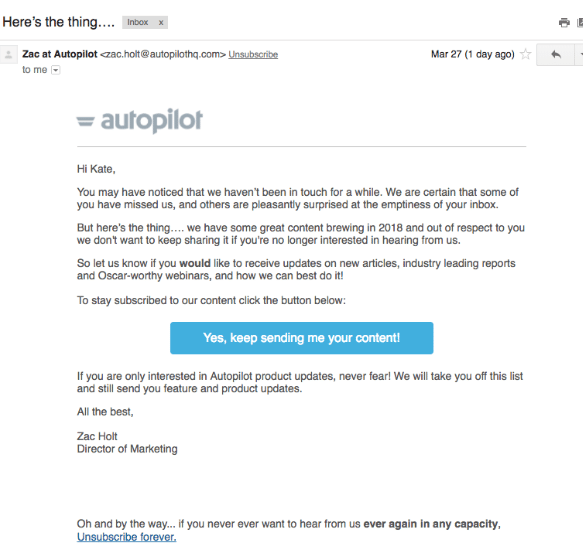
Humor may play in your favor, but keep in mind that everyone has different senses of humor, and you don’t want to offend people either.
A/B testing is a great way to see how these approaches work for you.
Convincing people who don’t open your emails to open a re-engagement email isn't’ going to be easy. You have to make them do a double take, and the subject line is where you can make this happen.
If your
subject lines tend to follow the same format after each send, try mixing it up so that the recipient instantly recognize that this email is different from others.
Proper Cloth, a men’s clothing line takes advantage of the subject line by providing an intriguing and click-worthy email, which happens to be the headline as well: Is this the end?
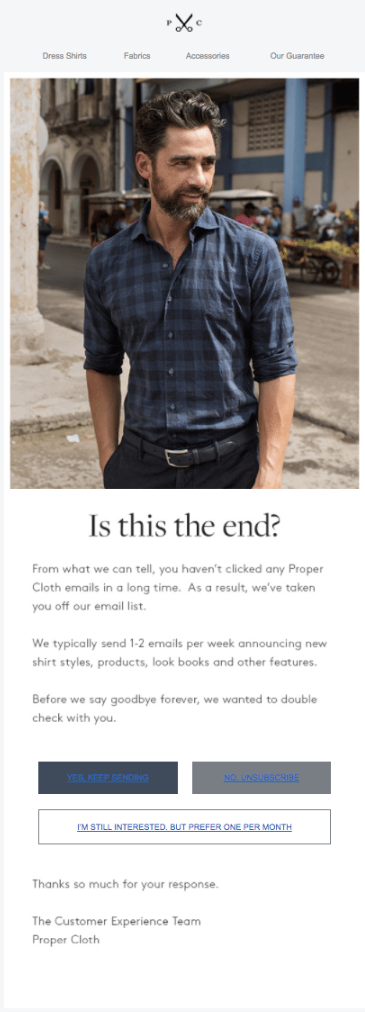
Notice that Proper Cloth defaults to removing all recipients on this send from their email list. But in addition to giving their recipients the chance to change their mind, they also provide them with an additional option to reduce their email frequency to once a month.
This strategy is great because it will keep the recipients who are most likely to engage in the future while also clearing their list of inactive and uninterested users. Their email subject line above is clear, concise, and just the right amount of cheeky.
If the recipient wants to remain on your email list, from the unsubscribe page, direct them to your preference center so they can adjust email frequency. If you have a robust preference center, they can fine-tune email frequency and request only certain types of emails.
Learn about which
type of preference center is best for your email program.
Bonus tip: ask for more feedback
Provide an option on your unsubscribe page that let’s recipients explain more about why they choose to be removed from your list. This is valuable information that will guide your email marketing strategy beyond just your re-engagement emails.
Give your recipients a compelling reason to interact with your brand again. Here are a few ideas to get you started:
- Exclusive Discounts: Discounts create a sense of urgency and value, making recipients more likely to take action and make a purchase.
- Freebies and Samples: Whether it's a free e-book, a sample of a new product, or access to a premium feature for a limited time, free offerings can spark interest and lead to increased engagement.
- Unique Content: This could include access to a webinar, a downloadable guide, or a sneak peek of upcoming content. By offering recipients something they can't get elsewhere, you create a sense of exclusivity and value.
- Personalized Recommendations: Tailoring your incentives based on recipients' past behavior or preferences can make your offers more relevant and appealing. For example, if a recipient has shown interest in a specific product category, you can offer a discount on related items, increasing the likelihood of re-engagement.
- Milestone Rewards: Celebrating milestones, such as a customer's anniversary with your brand or reaching a certain level of engagement, with special rewards can foster a sense of loyalty and rekindle their connection with your brand.
- Gamification Elements: You could offer recipients a chance to spin a virtual wheel for a discount or rewards, adding an element of excitement to the re-engagement process.
- Membership or Loyalty Programs: Inviting inactive customers to join or rejoin your loyalty program can provide them with ongoing incentives and rewards for continued engagement.
- Personalized Thank-You Messages: Sending a personalized thank-you message can create a positive sentiment and encourage recipients to return.
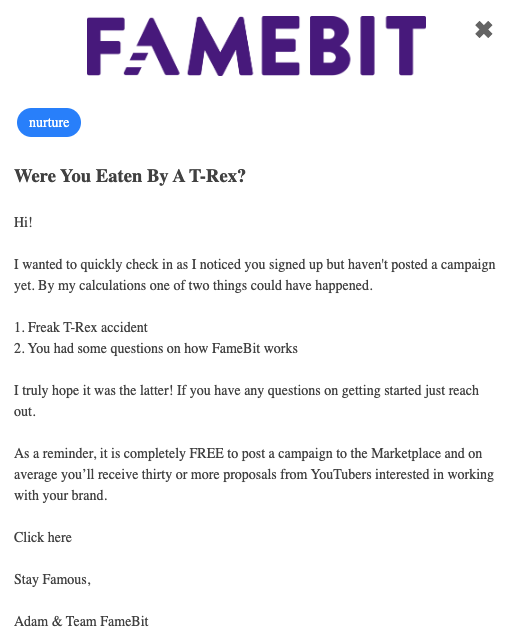 Famebit gets readers' attention with an interesting subject line: “Were You Eaten By a T-Rex?” It’s a fun email that shows the brand’s voice and sense of humor, and it also reminds users that they can start seeing the value of Famebit for free.
Famebit gets readers' attention with an interesting subject line: “Were You Eaten By a T-Rex?” It’s a fun email that shows the brand’s voice and sense of humor, and it also reminds users that they can start seeing the value of Famebit for free.
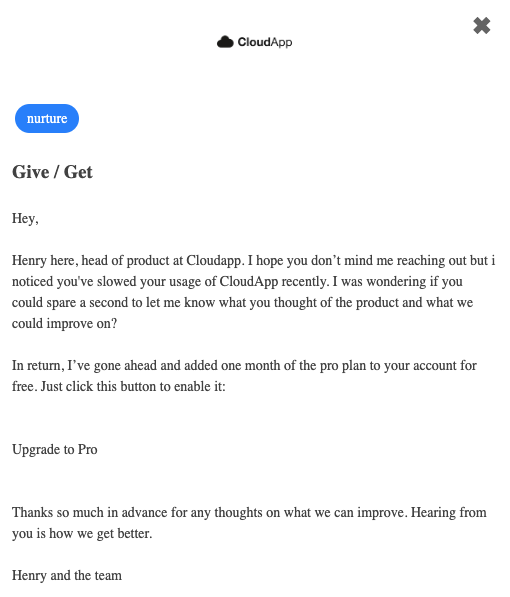 CloudApp’s re-engagement email campaign is a great example of asking for feedback. It’s trying to start a conversation with inactive users, and that’s a brilliant starting point for collecting valuable insights and re-engaging customers.
CloudApp also gave the users one month of the pro plan to incentive them to come back. They essentially reactivated a free trial (in a sense) to hopefully get the customer to realize the value of the product and stick with it.
CloudApp’s re-engagement email campaign is a great example of asking for feedback. It’s trying to start a conversation with inactive users, and that’s a brilliant starting point for collecting valuable insights and re-engaging customers.
CloudApp also gave the users one month of the pro plan to incentive them to come back. They essentially reactivated a free trial (in a sense) to hopefully get the customer to realize the value of the product and stick with it.
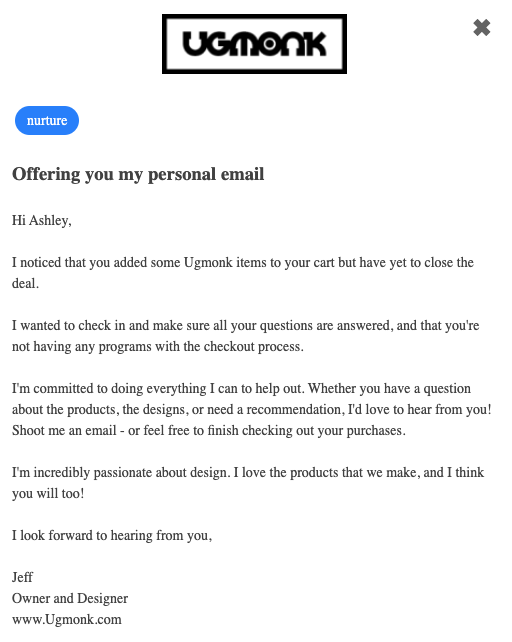 This re-engagement email campaign is a combination of an abandoned cart email and an engagement request. They’re reminding users that they didn’t complete their purchase, and they’re providing a personal email address for customers to share their thoughts or complaints.
This re-engagement email campaign is a combination of an abandoned cart email and an engagement request. They’re reminding users that they didn’t complete their purchase, and they’re providing a personal email address for customers to share their thoughts or complaints.
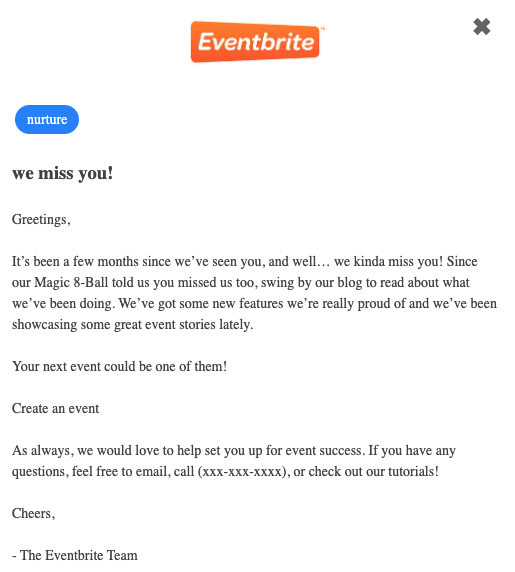 Eventbrite reinvites old users to engage with their product again. They link the customer out to a blog post that talks about all the cool new features, and they provide contact information to answer questions so the user can get started again quickly.
Eventbrite reinvites old users to engage with their product again. They link the customer out to a blog post that talks about all the cool new features, and they provide contact information to answer questions so the user can get started again quickly.
One of the biggest challenges for email marketers is to prove brand value and earn recipients’ trust enough that they open your emails. If you’re not achieving that with a segment of recipients, don’t be hard on yourself.
This isn’t necessarily a reflection of your content quality; it might just mean there was a disconnect between when they signed up and what they were really looking for. But if you take the time to solicit feedback and monitor the choices they make on your preference center, you’ve got an eye into how to improve your email program.
Need a reliable platform to send re-engagement email campaigns to your recipients? Look no further.
SendGrid provides robust
email list management features. You can use the Contacts API for programmatic, real-time updates, and you can create targeted manual lists or dynamic segments.
See for yourself.
Sign up for a free SendGrid account and start sending today.







